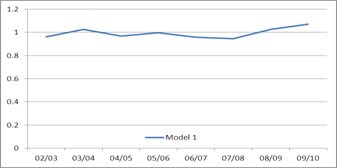Considerable differences in efficiency of housing associations
The one housing association operates more efficiently than another. On average, housing associations could reduce their operating costs by about 20 per cent. This was shown by a study by COELO and Rik Loolma Onderzoek & Advies published today in the ESB (Economisch Statistische Berichten) journal. COELO (Centre for Research on Local Government Economics) is a research institute associated with the FEB.
Housing associations find themselves in troubled waters at the moment. The sector has been put in a bad light due to several highly publicized incidents, such as the serious losses on Vestia’s derivatives portfolio. These incidents have focused attention on the efficiency of the housing associations. Minister for Housing and the Central Government Sector, Stef Blok, wants to see the housing associations reduce their operating costs. To determine to what extent this is possible, a large-scale efficiency study was conducted.
Determining efficiency
By comparing the ratio between output (production) and input (costs) of different housing associations, their relative efficiency can be determined. The efficiency score depends on what is measured as output. If only the core tasks of the housing associations are taken as output (model 1), then the average efficiency score is 0.77, on a scale of 0 to 1. This means that, on average, housing associations could reduce their operating costs by 23 per cent without impairing output. Under this model more than EUR 1.2 billion a year could be saved. If tasks related to quality of life and care are also included (model 2), then the average efficiency score is slightly higher. The potential savings would then amount to about a billion euros.
Table: Efficiency scores of housing associations
|
Model |
Output |
Average efficiency (on a scale of 0–1) |
Potential savings per year (million euros) |
|
1 |
Based on core tasks |
0,77 |
1.261 |
|
2 |
See model 1. Plus: quality of life score and housing/care arrangements |
0,83 |
992 |
Productivity does not improve by itself
There are no indications that efficiency has improved over the last ten years. The Malmquist indexes, which show change in productivity, hover around a value of 1, which means that efficiency has largely remained the same. Clearly there is insufficient pressure to realize the potential efficiency gains.
Figure: Average change in productivity of housing associations

The results of this study can be used in two ways to improve the efficiency of the sector. Firstly, the study shows which housing associations could improve their efficiency the most to bring it more in line with that of other associations. With this information these housing associations could be encouraged to improve their performance. Secondly, the scores calculated here could be used in a follow-up study to determine the reasons for these differences in efficiency. This could then provide tools for targeted government policy to further improve performance in the sector.
More information: Jacob Veenstra
Veenstra, J., Allers, M.A. & Koolma, H.M., 2013. Major differences in efficiency of housing associations. ESB, 98 (4668), 540-543.
| Last modified: | 01 February 2023 10.46 a.m. |
More news
-
19 April 2024
New thesis prize for master's students of Economics and Business
How can we encourage economics and business students to deal with important societal challenges in their master's thesis? The 14 Dutch faculties of economics and business, united in the Council of Deans in Economics and Business (DEB), have set up...
-
18 April 2024
Ward Romeijnders appointed as Professor of Optimization under Uncertainty
The Faculty of Economics and Business is pleased to announce that Ward Romeijnders has been appointed as Professor of Optimization under Uncertainty. The chair is situated within the Department of Operations.
-
12 April 2024
Inaugural Lecture Corine Noordhoff: Future ready retail
In her inaugural lecture, Professor of Retail Marketing Corine Noordhoff will provide insights in the cornerstones for survival and adaptation in the retail sector. Noordhoff’s inaugural lecture will take place on Friday 19 April 2024, 16:15 –...
